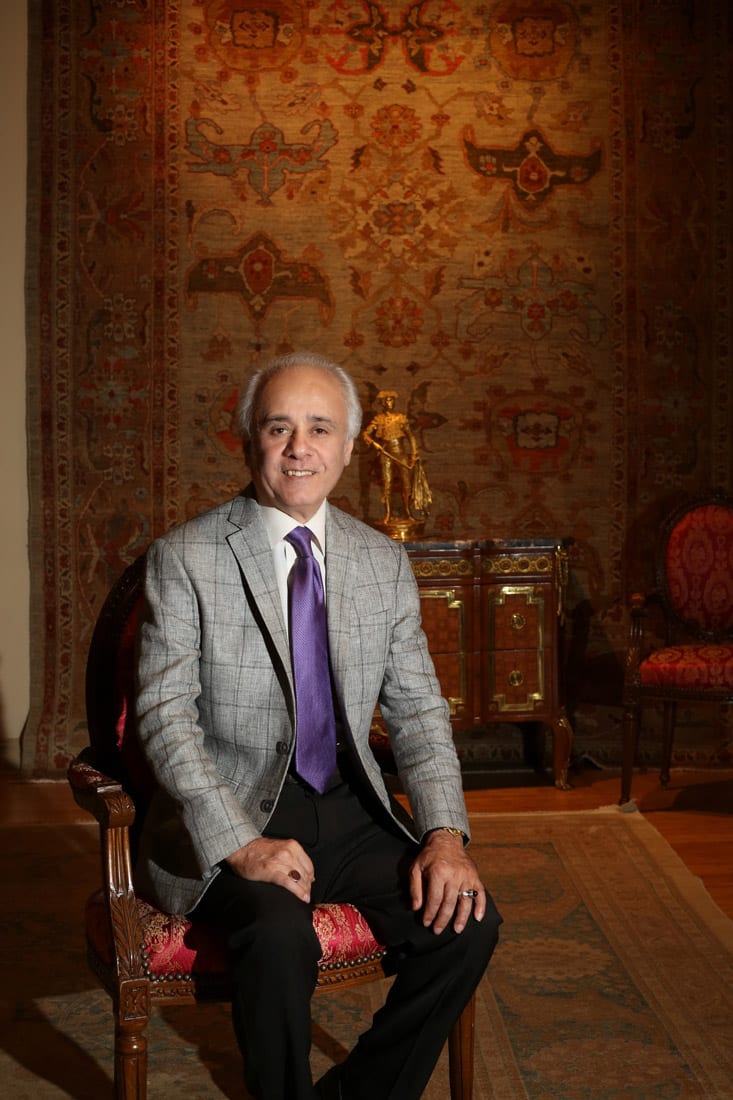Mohamad Gavahi of Atlanta Fine Rugs reveals how to shop for a quality Oriental rug

STORY: Karina Antenucci
PHOTO: Sara Hanna
Mohamad Gavahi’s family has been a purveyor of high-end antique rugs for generations. Originally a domestic business in Iran, the company was moved to Zurich, Switzerland, in 1979 so the Gavahis could expand their business internationally. A few years later, during trips to visit two of his brothers who were studying at Georgia Tech, Gavahi had the idea to open up a small shop in Atlanta as well. “I fell in love with Atlanta. I love the city. I love the people,” he says.
After opening the first showroom of Atlanta Fine Rugs on Cobb Parkway in 1984, the entire operation was eventually moved stateside. Today, the family maintains seven showrooms in the Southeast, including one on Buckhead’s Miami Circle managed by Gavahi’s daughter Niki, and they attend all of the big antique shows across the U.S. “We have one of the biggest selections of Persian and Oriental rugs in the country,” says Gavahi, whose clients include designers and individuals from all over the country, including celebrities such as Elton John and Jane Fonda. Here, Gavahi shares his know-how on selecting a quality rug.
What do the terms “Persian rug” and “Oriental rug” mean?
“Oriental rug” is generally used for rugs that are made by hand. There are many countries known to be involved in creating beautiful handmade rugs, such as Iran, Turkey, India, China and Pakistan. “Persian rug” means it was made in Persia. Persia is known for its history of rug-making, and the designs, ideas and color combinations used by all [rug makers] are 90% Persian.
What’s considered an antique rug?
It has to be at least 100 years old.
What’s the price of an Oriental rug based on?
Where it’s made, the material, the quality of the knotting, how old it is and what condition it’s in. The finer the knotting, the longer it takes to make, meaning more labor and a higher cost. Just like antique furniture, an antique rug from the 17th, 18th or 19th century will cost more because of its history, personality and character. Of course, when a rug is more than 100 years old, it’s not going to be like a brand-new rug, but it should be in fair condition. If it’s perfect, of course, it will be more valuable and expensive.
What should you look for in a legitimate merchant?
[Things such as] how long they’ve been in business, how they’ve treated their customers and what kind of reputation they have. Also, what selection do they have? If they’ve been in business for several decades, like we have, it shows you that they’re selling the right merchandise and taking care of customers.What’s the current trend in Oriental rugs?
The market has changed color-wise compared to 20 or 30 years ago. People are staying away from the strong, traditional colors. Softer colors are in. We have our own production in Turkey, India and Pakistan that manufactures these softer tones. Right now, there’s an embargo on the importation of Persian rugs.
How has that changed your business?
Before, we were one of the largest importers of Persian rugs in the U.S. Over the last five years, we’ve shifted to include antiques of all kinds at our showrooms, including furniture and art. We buy them in Europe and America, oftentimes from our older customers who are downsizing their homes.
ATLANTA FINE RUGS
752 Miami Circle N.E.
Atlanta 30324
404.760.0003
Managing Editor and Wellness Columnist at Simply Buckhead. Blogger at Badass + Healthy.
















